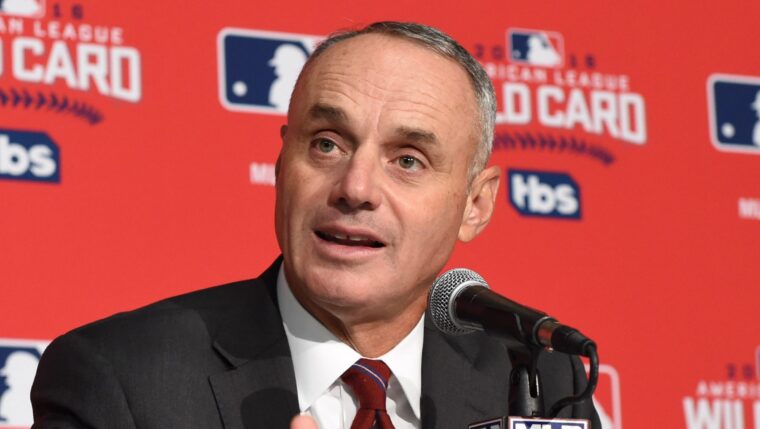
Major League Baseball and the Major League Baseball Players’ Association met in New York on Thursday. It was their sixth session since the lockout began 77 days ago, and it was the shortest one to date, lasting just 15 minutes. The Collective Bargaining Agreement (CBA) negotiations are stalled. Spring training has been delayed, and if there is no deal within 10 days, the regular season will be delayed.
In the time since December 2, there have been many low points. Most of the bargaining sessions that have taken place have lasted approximately an hour. They were often followed by statements of frustration and/or disappointment, then accusatory rhetoric, then long gaps between meetings. However, meeting for 15 minutes with the start of the regular season on the line may represent the nadir for both parties.
How did the players and owners get here? Let’s start with today’s liberally-termed “meeting”. The MLBPA put forth a revised proposal for the pre-arbitration bonus pool. They offered to have 80% of players with two-plus years of service, but fewer than three years of service in the pool. They asked to have $115 million in the pool (the owners have proposed $15 million), to be spread out over roughly 150 players. This is down from their previous ask of 100% of such players to be in the pool, but more than the current 22% (generally around 30) of these players considered “Super Two” players, and thereby eligible for arbitration before the usual three years of service time.
The owners have said they agree to the concept of a bonus pool, but will not budge off of 22% of players with between two and three years of service time being eligible (the bonus pool would replace arbitration for the select group of tow-to-three year players). This proposal by the MLBPA was likely quickly viewed as a non-starter (a favorite term in these negotiations), and therefore the meeting ended abruptly. The bonus pool and the minimum salary, which is also still under debate, represent two core economic issues.
Another core economic issue is the Competitive Balance Tax (CBT). This one is expected to be the most contentious topic of all in the negotiations, and it has not really been discussed in depth to date. Currently, the tax rates are as follows:
- $0-$20 million over the threshold: 20%
- $21 million-$40 million over the threshold: 32%
- More than $40 million over the threshold: 62.5%
MLB has proposed tax rates of 50%, 75%, and 100% for the new CBA.
Also at issue are the thresholds at which the tax would be assessed. For example, the players want the threshold to be $245 million in the first year of a new agreement, rising to $273 million in fifth year. The owners have proposed $214 million in year one, escalating to $222 million in year five. There is definitely a significant difference of opinion here, and little time to bridge the gap.
With the topics above, among others, far from resolved, it’s fair to wonder if there is any hope for the season to start on time (March 31). Things look bleak right now, for sure. If there is any thin ray of optimism to be found, it may be here, as reported by Chelsea Janes of The Washington Post:
Lead MLB negotiator Dan Halem just left after a side session with lead union negotiator Bruce Meyer. They stayed for an additional 20 minutes or so.
— Chelsea Janes (@chelsea_janes) February 17, 2022
The meeting between Halem and Meyer was described as “candid”. Hopefully, they agreed that the current deadlock is helping no one, and that they need to really get to work to avoid adversely impacting the 2022 season. Further, things are much more likely to move forward with fewer people involved in the negotiations. If Halem and Meyer can dedicate themselves to rolling up their sleeves, engaging in good-faith sessions, and shuttling information back and forth from their constituents, that may be the most positive development in some time.
Thursday’s brief meeting may not turn out to be as bad if the two sides agree to meet more frequently, beginning immediately. According to Evan Drellich of The Athletic, on Thursday MLB set a date of February 28 to have a new agreement to be able to start the season on time. It’s not clear if the players aligned to that timeline, but with four weeks of spring training needed, there’s not much room for debate .
Update: MLB told the MLBPA the date that a new CBA is needed by to start 2022 season on time is Feb. 28. Unclear if union agrees that is cut-off, but there cannot be much wiggle room, a few days at most. March 31 is opening day, and ST needs 4 weeks. @BNightengale mentioned 2/28.
— Evan Drellich (@EvanDrellich) February 18, 2022
The sense of urgency may be settling in. According to Jeff Passan of ESPN.com, the players and owners have agreed to intensify the pace of their negotiating sessions.
While exact plans are not finalized, MLB and the MLB Players Association intend to hold multiple bargaining sessions — perhaps every day — as early as Monday, sources told ESPN. Multiple owners and players expect to fly in for sessions leading up to MLB’s stated Feb. 28 deadline.
— Jeff Passan (@JeffPassan) February 18, 2022
We are now at the point where something unexpected needs to happen to salvage an Opening Day of March 31. Either MLB or the MLBPA will need to make an unexpected move in the other’s direction, that could be countered by a similar move by the other side in a different area. Rob Manfred has said that you’re always “one breakthrough away from an agreement.” That breakthrough needs to come in the very near future. At least they will be talking more regularly, which is certainly a welcomed, positive development.
One more point from the labor negotiations that has relevance given where we are on the calendar. In the meeting on February 12, MLB presented language that would allow for a lifting of the lockout if the sides align that they are close to an agreement, and resolve to negotiate in good faith to finalize a deal. So, if they can get fairly close by February 28, perhaps the players can get to work on the field, using the proposed language to ensure a concerted effort to finalize the details of a new CBA.
That’s it. The hope has now become a side conversation between Halem and Meyer, a deadline so the players and owners know when they will both start to lose money (who loses more is always debatable), more frequent negotiations, and some legal language to allow them to call it a touchdown with the ball on the ten yard line.
As we have said before, MLB and the MLBPA have put themselves in this situation. Both sides have accountability. Now they need a heroic effort over the next ten days to preserve a full 2022 season. Maybe there is little more hope given Passan’s tweet. Time will tell, and there is not much time left.















